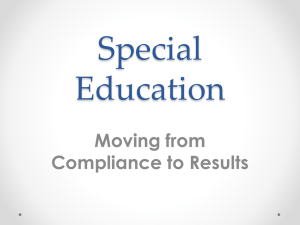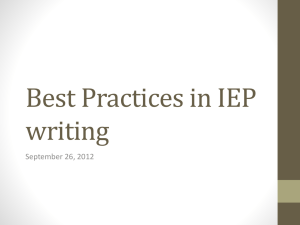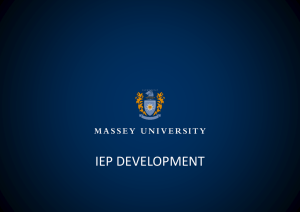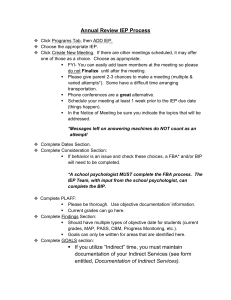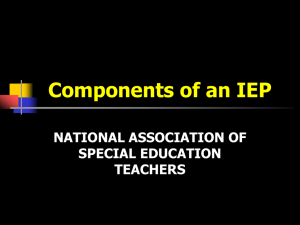Language Development Progress Monitoring
advertisement
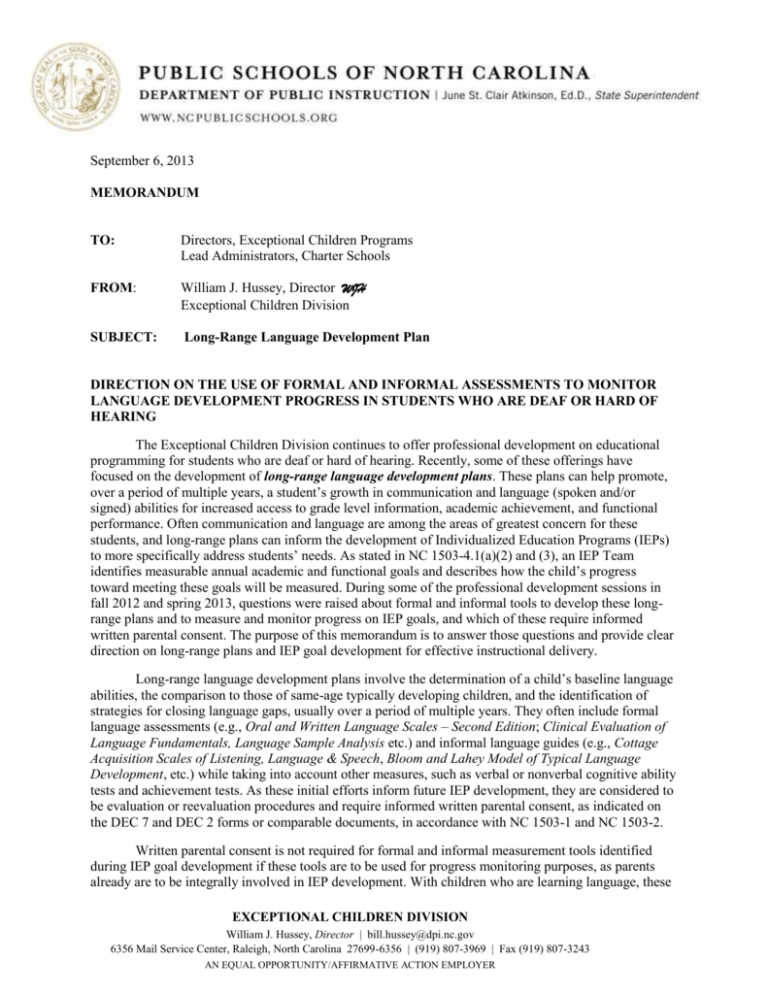
September 6, 2013 MEMORANDUM TO: Directors, Exceptional Children Programs Lead Administrators, Charter Schools FROM: William J. Hussey, Director WJH Exceptional Children Division SUBJECT: Long-Range Language Development Plan DIRECTION ON THE USE OF FORMAL AND INFORMAL ASSESSMENTS TO MONITOR LANGUAGE DEVELOPMENT PROGRESS IN STUDENTS WHO ARE DEAF OR HARD OF HEARING The Exceptional Children Division continues to offer professional development on educational programming for students who are deaf or hard of hearing. Recently, some of these offerings have focused on the development of long-range language development plans. These plans can help promote, over a period of multiple years, a student’s growth in communication and language (spoken and/or signed) abilities for increased access to grade level information, academic achievement, and functional performance. Often communication and language are among the areas of greatest concern for these students, and long-range plans can inform the development of Individualized Education Programs (IEPs) to more specifically address students’ needs. As stated in NC 1503-4.1(a)(2) and (3), an IEP Team identifies measurable annual academic and functional goals and describes how the child’s progress toward meeting these goals will be measured. During some of the professional development sessions in fall 2012 and spring 2013, questions were raised about formal and informal tools to develop these longrange plans and to measure and monitor progress on IEP goals, and which of these require informed written parental consent. The purpose of this memorandum is to answer those questions and provide clear direction on long-range plans and IEP goal development for effective instructional delivery. Long-range language development plans involve the determination of a child’s baseline language abilities, the comparison to those of same-age typically developing children, and the identification of strategies for closing language gaps, usually over a period of multiple years. They often include formal language assessments (e.g., Oral and Written Language Scales – Second Edition; Clinical Evaluation of Language Fundamentals, Language Sample Analysis etc.) and informal language guides (e.g., Cottage Acquisition Scales of Listening, Language & Speech, Bloom and Lahey Model of Typical Language Development, etc.) while taking into account other measures, such as verbal or nonverbal cognitive ability tests and achievement tests. As these initial efforts inform future IEP development, they are considered to be evaluation or reevaluation procedures and require informed written parental consent, as indicated on the DEC 7 and DEC 2 forms or comparable documents, in accordance with NC 1503-1 and NC 1503-2. Written parental consent is not required for formal and informal measurement tools identified during IEP goal development if these tools are to be used for progress monitoring purposes, as parents already are to be integrally involved in IEP development. With children who are learning language, these EXCEPTIONAL CHILDREN DIVISION William J. Hussey, Director | bill.hussey@dpi.nc.gov 6356 Mail Service Center, Raleigh, North Carolina 27699-6356 | (919) 807-3969 | Fax (919) 807-3243 AN EQUAL OPPORTUNITY/AFFIRMATIVE ACTION EMPLOYER tools can include the aforementioned instruments and other methods such as data charts, interviews, and teacher-made tests. An example of an acceptable measurement statement about an annual goal in language development on an IEP is ‘progress will be monitored using formal language assessments and informal language guides’. Though these tools must be related directly to the IEP goal being measured for progress, listing of precise titles on the IEP is not required. In addition, it is inappropriate to list other instruments and assessment methods that are not directly related to the IEP goal (e.g., a cognitive aptitude test for a language learning goal). Of note, a standardized cognitive measure, such as an IQ test, should not be used as a means of measuring progress. An IQ test is intended to obtain broad information about a student’s ability in particular areas of cognition, but it is not a narrow-enough measure of a student’s language progress. Therefore, a curriculum-based measurement would be more appropriate to measure a student’s progress, as it is a more narrow measure of skill. When standardized measures are used, it is important and necessary to consult the manual for training required of the examiner, as noted in NC 1503-2.5. Many standardized measures require administration by examiners with specific degrees and training. In addition, examiners must consult the manual regarding frequency of administration to the same student, as this can greatly impact the reliability and validity of the obtained results. It is hoped this memorandum provides clear answers to questions about long-range plans and progress monitoring for children who are deaf or hard of hearing. If you have further questions or would like information on future professional development offerings, please contact any of the Regional Consultants on the Deaf/Hard of Hearing Team (i.e., Krista Heavner, Sharon Moore, Michele Neal, Aubrey Quinlan, Rachael Ragin, and Sherri Vernelson) or the State Speech-Language Pathology Consultant, Perry Flynn. WJH/TW/IW/DM/PF/ms cc: Ira Wolfe, Section Chief Tom Winton, Section Chief Dreama McCoy, Section Chief



